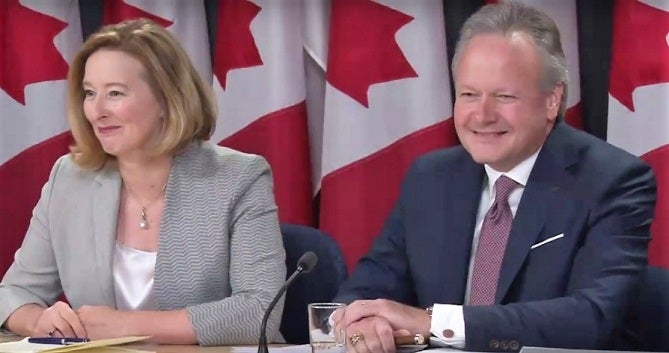Inside the Bank of Canada: armed guards everywhere, but no gold- Peter Diekmeyer (29/10/2018)

October 29,2018
This week’s Bank of Canada press conference, as always, was a communication professional’s dream.
A smiling Governor Stephen Poloz and Senior Deputy Governor Carolyn Wilkins defended the central bank’s 25 –basis-point rate hike with assessments about the economy, risks to the system and paths forward.The presentation was filled with impressive terminology like “stimulative monetary policy,” coupled with sophisticated references to three types of interest rates and five types of inflation.
Ordinary Canadians understood none of this.
That is how the Bank of Canada has for decades managed to effectively camouflage its incentivization of massive financial, debt and spending bubbles which have left the country tottering on the brink of ruin.
Following are key things that the central bank's clever media strategy is hiding.
Clueless about monetary policy
The Bank of Canada employs more than 100 economics PhDs and financial specialists. However the unstated fact is that they too are essentially clueless about monetary policy.
In today’s hyper-financialized world, even the best economists can’t define what money is. We know that cash is money. So are the digits in your bank account. But is a GIC that you can cash in tomorrow money? What about stocks and government bonds?
Economists’ inability to define money means that they don’t know how much they and the Big Banks have printed, nor what the inflation rate is.
The Bank has always been able to attract the country’s top people. However, as Ludwig von Mises noted a century ago, once price discovery is gone, effective understanding of the economy becomes impossible.
Central banks are set up to steal your money
An even funnier fact is that because universities teach little about economic history, few Canadians—even the Bank of Canada’s PhDs—know why it exists.
Many can recite rote definitions of its functions. These range from ensuring financial stability to targeting inflation and balancing that with economic growth. However, all of that stuff is incidental.
The Bank of Canada and its related institutions exist for one reason: to print money, which they then distribute to favored interest groups and obscure how this process impoverishes ordinary Canadians.
As John Maynard Keynes famously noted, not one man in a million understands how central banks rob people’s money. The Bank of Canada’s job is to make sure this stays that way.
The BoCs “cocaine cowboys” are sponsoring a Ponzi
Richard Fisher, the former head of the Dallas Fed, has likened loose central bank policy to giving the economy cocaine and heroin. Cheap money provides a short-term boost. But it requires ever-larger doses to keep it afloat.
However, the Bank of Canada’s governing council’s “cocaine cowboys” make the U.S. Federal Reserve look like rank amateurs.
According to Statistics Canada data , the central bank’s loose interest rates have hooked Canadians on a debt-growth path, which has doubled personal, business and government liabilities since the financial crisis to $6.1 trillion as at June 2018.
Even a cursory look suggests that the Bank of Canada’s model is a Ponzi scheme. In fact stabilizing debt levels would be impossible without collapsing the system.
Armed guards everywhere … but no gold .
The Bank of Canada’s worst failure has been its complicity with the Liberal government in selling off Canada’s emergency gold reserves.
This during a time when Russia, China ,and other key world central banks have been stocking up and repatriating their own gold stocks, in order to prepare for the worst.
Bank of Canada officials point to Canada’s Finance Minister as bearing responsibility for ordering the gold sales.However until they speak out on this issue, they remain complicit.
Warren Buffet once said that it’s only when the tide flows out that you find out who is swimming naked. Right now Canada needs a bathing suit.
Free markets in money
Sadly, checks on the Bank of Canada’s rogue monetary policies are essentially impossible.
The complexity of the verbiage, formulations and statistics that academic economists have developed over the decades to justify and mask their actions are such that any efforts to control them, would soon be reversed.
The only possible check on unconstrained government borrowing, spending and money printing is thus a free market in currencies.
This would minimize central bank theft and enable traders to fairly identify and quantify the extent of currency debasement.
Yet while Canadians don’t understand monetary policy they love and trust government. That is why it is so easy to pick their pockets.
That’s also why that the path forward starts with Polaz and Wilkins refusing to be part of the charade.
Don’t miss a golden opportunity.
Now that you’ve gained a deeper understanding about gold, it’s time to browse our selection of gold bars, coins, or exclusive Sprott Gold wafers.
About Sprott Money
Specializing in the sale of bullion, bullion storage and precious metals registered investments, there’s a reason Sprott Money is called “The Most Trusted Name in Precious Metals”.
Since 2008, our customers have trusted us to provide guidance, education, and superior customer service as we help build their holdings in precious metals—no matter the size of the portfolio. Chairman, Eric Sprott, and President, Larisa Sprott, are proud to head up one of the most well-known and reputable precious metal firms in North America. Learn more about Sprott Money.
Learn More
You Might Also Like:
















Comments